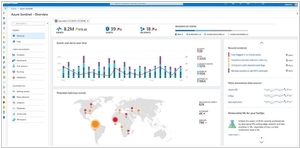Darktrace vs Microsoft Sentinel
August 05, 2023 | Author: Michael Stromann
See also:
Top 10 SIEM software
Top 10 SIEM software
Darktrace and Microsoft Sentinel are two prominent cybersecurity solutions, but they approach security from different angles. Darktrace specializes in leveraging artificial intelligence (AI) and machine learning to create a self-learning Cyber AI platform. It excels in real-time anomaly detection, identifying abnormal behavior across an organization's network and cloud environments. Darktrace's autonomous response capabilities allow it to proactively respond to emerging threats, making it a valuable tool for organizations seeking a proactive approach to cybersecurity.
On the other hand, Microsoft Sentinel is a cloud-native security information and event management (SIEM) platform integrated with the Microsoft Azure ecosystem. Sentinel offers a centralized view of an organization's security landscape, utilizing advanced analytics and automation to detect and respond to security incidents across the entire network. Its AI-driven capabilities enable it to analyze massive amounts of data from various sources, including logs, cloud services, and endpoints, providing a broader and more holistic view of an organization's security posture within the Azure environment. Microsoft Sentinel is particularly advantageous for businesses heavily invested in the Azure ecosystem, providing a unified security experience.
Another key difference lies in their deployment models. Darktrace typically offers a cloud-native deployment, providing the benefits of scalability, automatic updates, and reduced maintenance overheads. This makes it attractive for organizations seeking cloud-based solutions and ease of management. In contrast, Microsoft Sentinel can be deployed as a cloud-native solution or can integrate with on-premises infrastructure, offering greater flexibility for organizations with specific data privacy and compliance needs. This difference allows organizations to choose the deployment model that aligns best with their existing infrastructure and cloud preferences.
See also: Top 10 SIEM software
On the other hand, Microsoft Sentinel is a cloud-native security information and event management (SIEM) platform integrated with the Microsoft Azure ecosystem. Sentinel offers a centralized view of an organization's security landscape, utilizing advanced analytics and automation to detect and respond to security incidents across the entire network. Its AI-driven capabilities enable it to analyze massive amounts of data from various sources, including logs, cloud services, and endpoints, providing a broader and more holistic view of an organization's security posture within the Azure environment. Microsoft Sentinel is particularly advantageous for businesses heavily invested in the Azure ecosystem, providing a unified security experience.
Another key difference lies in their deployment models. Darktrace typically offers a cloud-native deployment, providing the benefits of scalability, automatic updates, and reduced maintenance overheads. This makes it attractive for organizations seeking cloud-based solutions and ease of management. In contrast, Microsoft Sentinel can be deployed as a cloud-native solution or can integrate with on-premises infrastructure, offering greater flexibility for organizations with specific data privacy and compliance needs. This difference allows organizations to choose the deployment model that aligns best with their existing infrastructure and cloud preferences.
See also: Top 10 SIEM software





